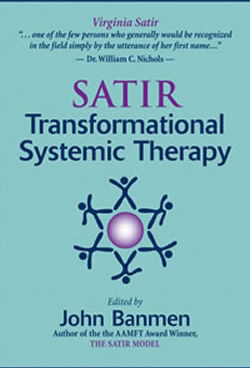 |
|

SATIR
Transformational Systemic Therapy

John
Banmen
249
pages, 6 x 9 in.,
ISBN 978-0831400927
$29.95
Virginia
Satir's approach to therapy helped people change at a deep level,
and this book sheds light on how that works. Most of these chapters
first appeared in one of the best-selling issues ever of the journal
Contemporary Family Therapy. A special edition devoted to current
applications of the Satir model of family therapy, it offered international
perspectives on various issues, from congruence to positive psychology,
and from Family Reconstruction to spirituality.
Cross-cultural counseling, treating suicidal youth, and working with survivors
of sexual abuse also feature here, as does the therapist's use of him- or herself
as part of this systemic approach to counseling.
Critiquing, developing, and adapting the Satir
model characterize chapters in this book. In his preface, John Banmen
describes the evolution of that model over the past twenty years. As
director of training at the Satir Institute of the Pacific, he is well
qualified to know. His work takes him from Canada to Hong Kong, Korea,
Singapore, Taiwan, the United States, and Europe. Among his contributing
authors from those countries, almost all practice and train others
to use Satir's systemic therapy.
The book's foreword is by Dr. William C. Nichols former president of both the
American Association of Marriage and Family Therapy and of the International
Family Therapy Association. In it, he details how he initiated the special journal
edition and how it came together. A comprehensive overview of this book also
appears in his foreword, where he writes that many therapists regarded Virginia
Satir". . .one of the few persons who generally would be recognized in the field
simply by
utterance of her first name. . . ” After she died, “the expressions
were uniformly those of bereavement, loss, affection, and respect.” Readers
who do not already share such feelings may experience several glimpses of them
as they enjoy this book.
|

|
|
|
|
 |
|
